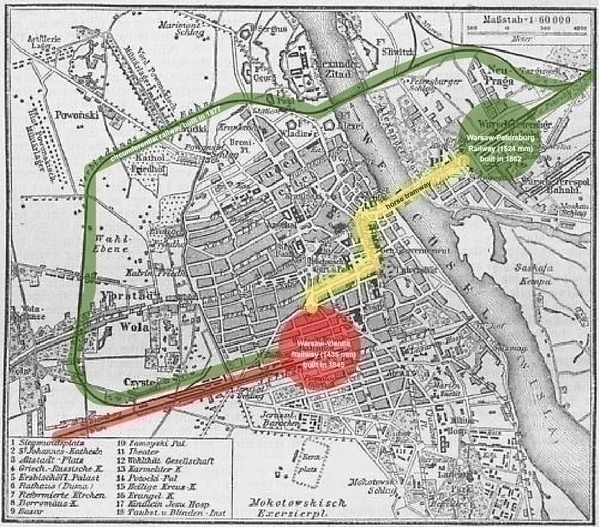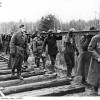Cumbersome connection

Map of Warsaw in 1860s showing the location of railway stations of two lines using standard (red) and broad (green) gauge.
The Warsaw–Vienna railway line was the first to connect the Russian Empire with the rest of Europe. The connection was initiated by businessmen in Poland who had a vision of linking it to existing lines in Austria. To do this, they chose the 1435 mm Stephenson gauge, which had been adopted as the standard in Austrian Empire in the late 1830s on its first steam line, which ended near Krakow.
The Warsaw–Vienna line opened for traffic in 1845 and quickly became the major transfer point for most passengers and goods going from Austria to the Russian empire. From Warsaw, people and goods had to be transferred to carts and carriages in order to go further into Russia. After the Warsaw–St. Petersburg railway line opened in 1862, the city retained its position as the main point linking Russia with railway networks beyond – and it still involved horses. The broad gauge line from St. Petersburg stopped on the east bank of Vistula River, while the terminal of the Warsaw–Vienna line was on the opposite bank.
For more than thirty years, passengers traveling between Russia and the West were transferred by horse tramways between the two stations. While a rail link between the stations was built in 1876, passengers and freight still had to change trains from standard to Russian gauge.
 Previous Story
Next Story
Previous Story
Next Story
How to cite this page
Slawomir Lotysz, 'Cumbersome connection', Inventing Europe, http://www.inventingeurope.eu/governance/cumbersome-connection
Sources
- Walsh, Edmund A. The Fall of the Russian Empire: The Story of the Last of the Romanovs and the Coming of the Bolsheviki. Boston: Little, Brown, and Company, 1928.



















